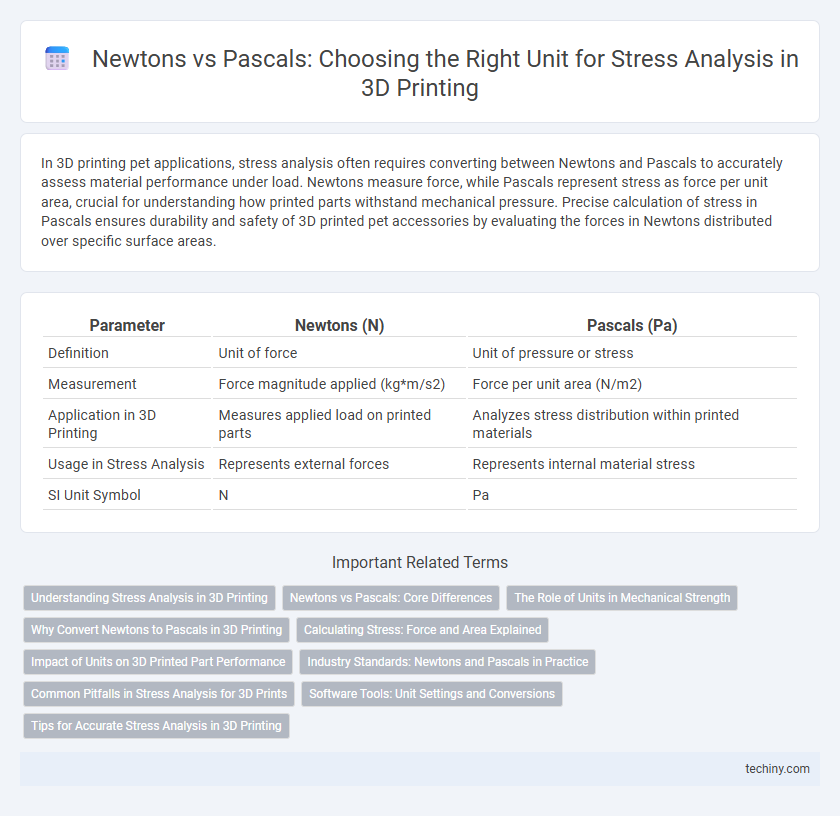In 3D printing pet applications, stress analysis often requires converting between Newtons and Pascals to accurately assess material performance under load. Newtons measure force, while Pascals represent stress as force per unit area, crucial for understanding how printed parts withstand mechanical pressure. Precise calculation of stress in Pascals ensures durability and safety of 3D printed pet accessories by evaluating the forces in Newtons distributed over specific surface areas.
Table of Comparison
| Parameter | Newtons (N) | Pascals (Pa) |
|---|---|---|
| Definition | Unit of force | Unit of pressure or stress |
| Measurement | Force magnitude applied (kg*m/s2) | Force per unit area (N/m2) |
| Application in 3D Printing | Measures applied load on printed parts | Analyzes stress distribution within printed materials |
| Usage in Stress Analysis | Represents external forces | Represents internal material stress |
| SI Unit Symbol | N | Pa |
Understanding Stress Analysis in 3D Printing
Stress analysis in 3D printing involves evaluating internal forces to predict material behavior under load, where Newtons (N) quantify force and Pascals (Pa) measure stress as force per unit area. Accurate interpretation of stress requires converting applied Newtons to Pascals by dividing by the cross-sectional area of the printed part, enabling simulation of mechanical performance. Finite element analysis (FEA) software commonly uses Pascals for stress distribution visualization, aiding in optimizing 3D printed designs for durability and structural integrity.
Newtons vs Pascals: Core Differences
Newtons measure force as the product of mass and acceleration, fundamental for quantifying load applied to 3D printed components. Pascals quantify stress by expressing force per unit area (Newtons per square meter), essential for evaluating material strength and deformation under load. Understanding the core difference between Newtons and Pascals allows engineers to accurately analyze mechanical behavior and optimize 3D print designs for durability and performance.
The Role of Units in Mechanical Strength
In 3D printing, understanding mechanical strength requires accurate stress analysis where units like Newtons and Pascals play crucial roles. Newtons quantify force applied on a material, while Pascals measure the resulting stress by dividing force by the cross-sectional area. Using Pascals allows for standardized comparison of strength properties across different printed structures, ensuring precise evaluation of mechanical performance.
Why Convert Newtons to Pascals in 3D Printing
Converting Newtons to Pascals in 3D printing is essential for accurate stress analysis, as Newtons measure force while Pascals quantify pressure or stress over an area. Understanding stress in Pascals allows engineers to predict material behavior under load, ensuring optimal design and preventing structural failure during the printing process. This conversion enhances precision in evaluating mechanical properties, leading to improved durability and performance of 3D-printed parts.
Calculating Stress: Force and Area Explained
Stress in 3D printing is calculated by dividing the applied force, measured in newtons (N), by the cross-sectional area, measured in square meters (m2), resulting in stress values in pascals (Pa). Understanding this relationship allows for precise analysis of material behavior under load, ensuring structural integrity of printed components. Accurate stress calculation guides the selection of appropriate printing parameters and materials to optimize strength and durability.
Impact of Units on 3D Printed Part Performance
The choice between Newtons and Pascals in stress analysis significantly affects the interpretation of 3D printed part performance by distinguishing between force measurement and stress distribution within materials. Newtons quantify the applied force on a 3D printed component, while Pascals define stress as force per unit area, crucial for evaluating material strength and deformation under load. Accurate unit application ensures reliable simulations and structural integrity assessments, optimizing design parameters for enhanced durability and functionality in additive manufacturing.
Industry Standards: Newtons and Pascals in Practice
Industry standards in 3D printing stress analysis commonly use Newtons (N) to measure force and Pascals (Pa) to quantify stress on materials, ensuring precise assessment of structural integrity. Newtons represent the applied force on a printed component, while Pascals express the resulting stress distribution within the material, facilitating accurate evaluation of mechanical performance. Adhering to international standards such as ISO 527 and ASTM D638 ensures consistent interpretation and comparison of stress and force metrics across additive manufacturing processes.
Common Pitfalls in Stress Analysis for 3D Prints
Stress analysis in 3D printing often suffers from confusion between Newtons and Pascals, where users mistakenly treat force units (Newtons) as pressure or stress units (Pascals). This misinterpretation leads to inaccurate assessment of material strength and failure thresholds, critically undermining the reliability of printed parts. Correctly distinguishing between force and stress units ensures precise evaluation of load-bearing capacity and structural integrity in 3D printed designs.
Software Tools: Unit Settings and Conversions
In 3D printing stress analysis, software tools typically support unit settings in Newtons (N) for force and Pascals (Pa) for pressure or stress, where 1 Pascal equals 1 Newton per square meter (N/m2). Accurate unit conversion between Newtons and Pascals is critical for precise simulation results, ensuring material strength and load distribution calculations align with real-world conditions. Common CAD and FEA software like ANSYS, SolidWorks, and Fusion 360 allow users to customize unit parameters, facilitating seamless conversion and consistent data interpretation across different design stages.
Tips for Accurate Stress Analysis in 3D Printing
Accurate stress analysis in 3D printing requires understanding the difference between Newtons and Pascals; Newtons measure force, while Pascals quantify stress as force per unit area. Applying stress in Pascals allows for precise evaluation of material strength and deformation under load within printed structures. Utilize calibrated sensors and finite element analysis software to convert applied forces into stress distributions for optimized design and reliable mechanical performance.
Newtons vs Pascals (for stress analysis) Infographic

 techiny.com
techiny.com